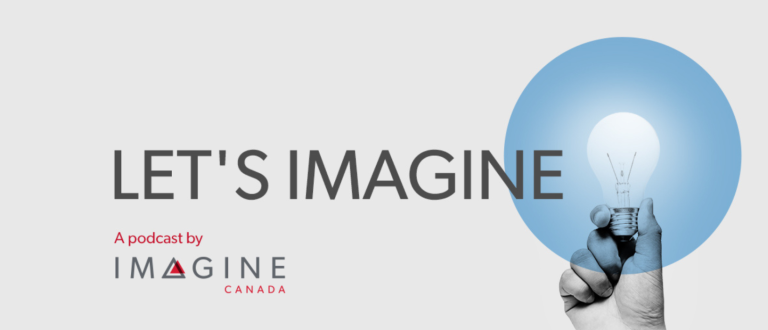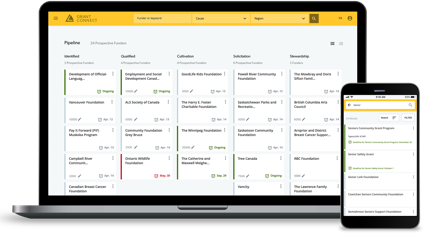The CanadaHelps Giving Report sums 2023 as a year “defined by inflation” and rife with challenges for charities and nonprofits, as demand for services continues to rise while donations and volunteerism trend downward. More than ever, fundraisers need to diversify revenue sources to ensure organizational stability in this turbulent environment.
However, 2023 was also a year of positive change for the sector, with increased advocacy around core funding, support for equity-seeking organizations, and trust-based partnerships between funders and nonprofits.
Ahead of another year filled with both challenges and opportunities, we’re revisiting our 8 Shifts in the Grants Landscape blog post from late 2022 and providing updates and new insights on the evolution of our sector.
1. The disbursement quota increased from 3.5% to 5% on assets over $1 million.
In early 2023, the disbursement quota (DQ) – the percentage that registered charities such as foundations are required to disburse each year – increased for the first time in over a decade. While unlocking more funding for charities and nonprofits is a positive change, some philanthropic leaders like Rebecca Darwent find the increase insufficient for a "world on fire,” while large sums of money remain untouched in endowments or donor-advised funds. Some funders, such as the Ivey Foundation, are taking radical and proactive steps like disbursing their entire endowment between 2023 and 2027 and winding down operations to prioritize immediate impact over perpetual wealth stability. In 2024, we’ll be paying attention to changes in giving from larger organizations that may result from the DQ increase.
2. Funders are making lasting commitments to support equity-seeking communities.
The stark funding imbalances for equity-seeking organizations (see The Unfunded Report for some harrowing statistics from 2020 on B3 orgs, in particular) are a function and result of the nonprofit sector’s roots in white supremacy and colonialism. While that legacy will take many years to overcome, continued investment in equity-seeking communities through organizations like the Canadian Race Relations Foundation (who opened a second round of their National Anti-Racism Fund in January 2024), the Definity Foundation (a new funder who committed over 60% of their $8.4 million inaugural investment to Indigenous-led and serving initiatives), and the Foundation for Black Communities (who were recently awarded stewardship of the $200 million federal Black-Led Philanthropic Endowment Fund, and partnered on the federal Investment Readiness Program earlier in 2023) inspires hope that a sustained shift is taking place toward more equitable, community-informed, and community-led funding practices. In 2024, we strongly encourage more funders and government bodies to draw inspiration from these examples and meaningfully invest in equity-seeking organizations and communities.
3. Non-charities can now receive funding from charities in the form of “qualifying disbursements”.
In 2022 and early 2023, the Canada Revenue Agency (CRA) amended the Income Tax Act and released draft legislation that allows registered charities to directly fund non-charities. This sector-advocated shift away from outdated “direction and control” language and policies (which required charities to assume legal ownership over the activities of non-charities, thereby hindering equitable partnerships) will create access to funding for grassroots groups, mutual aid networks, some Indigenous and First Nations bands, and other non-charities that carry out vital services in equity-seeking communities. At the end of 2023, the CRA released their finalized guidance on these changes: CG-032 Registered charities making grants to non-qualified donees. In the coming months, look out for a joint blog post from Grant Connect and Imagine Canada’s Public Policy team describing how charities and non-charities are putting this new legislation into practice and how you might be able to do the same!
4. AI is changing the way we fundraise
In 2023, artificial intelligence (AI) – and especially generative AI systems, like ChatGPT – exploded into the public sphere. Nonprofit professionals quickly saw the potential for these tools to speed up their fundraising communications, and tools like MailChimp, Canva, and iWave responded with AI integrations. However, with this new technology comes new ethical considerations. Grantwriters may find AI useful to significantly reduce the time spent writing funding proposals, but need to be aware of its inherent limitations – such as the ways in which AI trained on limited and biased data can then reproduce bias, decentralize humans, and fail to capture or understand complexity. Data consultant Meena Das urges nonprofits to always retain accountability and centre community when working with AI, which Furniture Bank reflects on in their Responsible AI Manifesto. This year, we’ll be curious about the interplay between AI tools and grant processes – and hoping that the use of AI doesn’t prop up and reinforce existing barriers like lengthy applications, but rather spurs further change on the funder side toward grantmaking rooted in trust and partnership.
5. Social finance and impact investing are gaining popularity in the sector.
Nonprofits are engaging in social finance to diversify their funding sources, access capital, and overcome challenges with traditional financing models. Social finance – sometimes called “impact investing” – describes a private entity investing capital in a social purpose organization or project with the expectation of a financial return alongside social, cultural or environmental impacts. Check out Imagine Canada’s recently-released Social Finance Report (which includes case studies from 22 organizations participating in social finance) to get a clearer picture of what social finance is, and how organizations, investors, and communities can benefit from it.
6. Participatory grantmaking and trust-based philanthropy are changing the fabric of grantor-grantee relationships.
Trust-based philanthropy is increasingly being recognized throughout the sector as an approach that advances equity, shifts power, and fosters mutually accountable relationships. The tenets of trust-based philanthropy, such as offering long-term flexible funding and taking a relational approach in application design, centre grantee and community needs, resources, and knowledge. Another way more funders are achieving this community-centric approach is through participatory grantmaking, which brings community members to the table as active decision-makers and collaborators in the funding process. Funders like the WES Mariam Assefa Fund, the International Trans Fund, Vancouver Foundation, and the Foundation for Black Communities exemplify approaches that recognize the value of community knowledge, collaborative program design, and trust-based relationships between grantors and grantees. In 2024, keep an eye out for new research from Imagine Canada’s Caring Companies program detailing over 1000 Canadian nonprofits’ perceptions and expectations on corporate community investment, with themes of exploration including trust, relationship-building, and collaboration.
7. Pandemic-era funding has largely dried up while organizations continue navigating COVID-19’s aftermath.
Many of us have recently returned from winter holidays that could be described as a “post-pandemic” balancing act – attending large gatherings while also attempting to dodge COVID-19 and other contagions on the rise. Although the World Health Organization ended COVID-19’s public health emergency status in May 2023, communities continue to reel in the aftermath of a pandemic that exacerbated social inequities and changed the way many organizations find resources. At the onset of COVID-19, federal emergency funding and emergency support from foundations helped charities and nonprofits stay operational and meet the spiking demand for services. Although the demand on nonprofits remains high due to complex social and economic circumstances amplified by COVID-19, pandemic-era support has largely ceased. Exactly how the philanthropic sector will need to evolve in order to stay effective and relevant in the future has been the object of much recent study:
“As all industries grapple with their future in a post-pandemic landscape, so too does the philanthropic, considering broad-based topics like: funding challenges, the work required of us all to address equity, diversity and inclusion and how we create safe spaces for our teams and stakeholders, attracting and retaining the best talent, transparency within our operations, and adjusting course to be relevant and impactful in the future.” - Global Philanthropic Canada
In 2024 and beyond, we’ll be heeding the advice of philanthropy’s “reformers” and new generations of leaders who call for building equitable partnerships, centering community, prioritizing flexibility and trust, cultivating and better supporting workers in the sector, embracing discomfort, and resourcing creativity and connection to better prepare for future challenges.
8. More than ever, data is power in your grantseeking strategy.
A flood of global and local data relating to social and environmental issues is playing an increasingly important role in philanthropic decision-making. For example, many corporations and community foundations have begun aligning their social investment strategies with the United Nations’ 17 sustainable development goals. Organizations who know how funders are approaching their priorities – and how to identify, measure, and report on the alignment between these priorities and their own organization’s impact – will increasingly be at an advantage when it comes to making their case for support. Detailed information about individual foundations and other charities is publicly available through the Canada Revenue Agency’s T3010 finder. Grant Connect, Imagine Canada’s fundraising research platform, compiles high-quality data from these T3010s as well as funder websites, annual reports, and direct communication with funders to equip fundraisers with as much information as possible, helping you navigate the grants landscape and make decisions about who to partner with in pursuit of your mission.
___
Prospecting and grant writing can be a lonely job, but you’re not alone! All across the sector, funders, charities, nonprofits, sector advocates, and policymakers are working together toward resilience, sustainability, and equity in the face of current and future challenges. Though the sector and the world continue to navigate tension and turbulence, we’re seeing continued signs of progress toward a funding environment built on trusting relationships, community expertise, and cross-sector collaboration that reflect our interconnectedness.
Are we missing any great new trends or developments in grantseeking that you think we should know about? Want to share an opinion or a success story? We’re all ears! Email us at grantconnect@imaginecanada.ca.
Additional Resources
- The Status of Canadian Fundraising 2023: Benchmark Report (Blackbaud)
- The Future of Giving: Looking Beyond the Selfie (Paypal Giving Fund and AgentsC Inc.)
- The Giving Report 2023 (CanadaHelps)
- What Nonprofits Can Expect in 2024 and How to be Better Prepared (CharityVillage)
- Trust & Impact: Funders’ Perspectives on Unrestricted Funding (Imagine Canada)
- Generative AI Adoption Index (KPMG)




